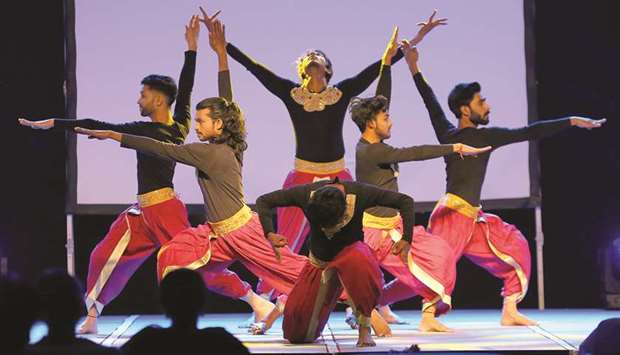Classical Indian dance mirrors traditional Indian culture. Culture diffuses from the lowest levels of simplicity to the strata of complexity. Indian classical dance is closely knitted with emotions. It resembles a perfect harmony between classical music and bodily movement. In fact, its objective can be summed up as the creation of different moods in the minds of the spectators. Indian classical dance is an expression that caterwaul traditions.
Dishaa Creative Dance Group recently presented ‘Contemporary Dance Performance’ at Ballroom in St. Regis Hotel as part of the ‘India-Qatar Year of Culture 2019’ celebrations. Rich in colours, swift body movements and the spell binding rhythm of each step was all about drama and sophistication.
The dance performance provided a glimpse of India’s rich cultural heritage. It was a fitting tribute to the immense diversity that India offers and also to the links between India and Qatar in the field of culture and music.
The event was an amalgamation of several Indian dance styles and was enacted by a troupe of 12 performers. The dance group had structured its performance around six themes in six parts, including Aura, Elements, Two shades, Mohe Rang Do Laal, Jugalbandhi (fusion) and Holiya me ude gulaal.
Aura highlights the significance of spirituality in our lives. It fused together yoga movements and Indian contemporary dance form. The music had the Indian elements like the sound of conch shells, several chants and various Indian musical instruments. Elements was based on two life supporting elements – fire and water. The dancers showed the nature, movement and feel of the two elements. Two Shades depicted the two sides of life – harsh realities and the joyous breezy moments that balance life.
Mohe rang do laal was a solo kathak and semi classical dance showing the Radha- Krishna love saga and their significance in the Holi festival. Jugalbandhi (fusion) had a fusion of different Indian dance forms, including Mayurbhanj Chhau (Indian martial art form from Odisha), Kathak, Odissi, contemporary and semi-classical dance highlighting the diversity of India.
Holiya me ude gulaal had Rajasthani folk dance on a very popular song by Ila Arun. It had colourful costumes and Indian folk dance movements including Kikli showing Indian roots and the playfulness of Holi.
Speaking on the occasion, P Kumaran, Ambassador of India, said, “I am really happy that you all have joined us today for the contemporary dance performances. This is the fourth event that we are organising under India-Qatar Year of Culture 2019. We have a number of events lined up for the coming weeks and months. The next event will be a table performance by the India’s first female table player.
Today’s event is about contemporary Indian dances. There is a lot of confusion regarding what it means. To explain in a simple way, Indian contemporary dance is something that is inspired by Indian classical dance forms. However, they are not bound by strict grammar and rules that have become extremely rigid over many centuries. The contemporary dance form gets a fair amount of freedom for creative expressions. There is latitude to try and assimilate other forms of dances. Some people even compare it to ballet because of the large amount of leg work involved in these dance forms. Overall, there are a lot of new troupes emerging in the area of contemporary dance.”
Talking to Community, Faisal al-Hajri, a Qatari artist, said: “It was a good opportunity to see Indian culture, legacy and history at the dance performance. The performances were elegant, modern and contemporary. The dances gave you deep and authentic feelings of Indian culture, spiritual and empowering energy. I always love to attend cultural events organised by the Indian community in Doha.”
Aldi Stassen, a Dutch expatriate and artist, added, “I was intrigued to see the amazing combination of ballet and yoga. The performances were very well choreographed. The artists were well trained and disciplined. It was great to see the combination of body and mind. All the dance performances were well corresponding. It was really amazing to see the performances.”
Rashmi Agarwal, President of MAPS International WLL, said, “We are very thankful to the Indian embassy for organising a wonderful and colourful programme. It was very fortunate for me to attend the event and get the deep knowledge of different dance forms. I really enjoyed the unique combination of dance and music. As an Indian expatriate, I was happy to see people of different nationalities enjoying and appreciating the event.”

PERFORMANCE: Dishaa Creative Dance Group putting up a rich in colour and sophisticated performances. Photos by Ram Chand
